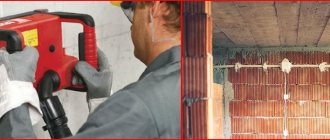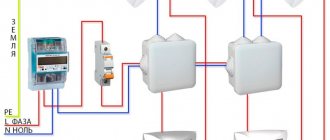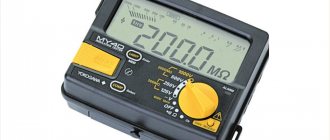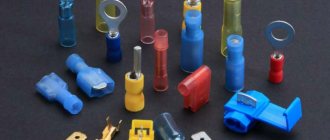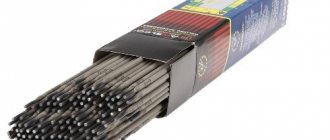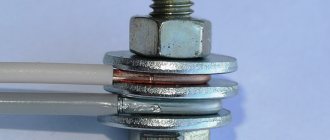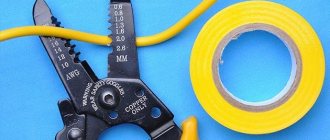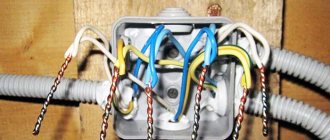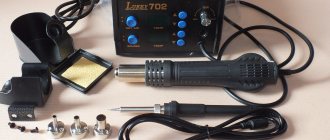SHARE ON SOCIAL NETWORKS
FacebookTwitterOkGoogle+PinterestVk
To perform any work with electrical wires, you cannot do without a special tool designed to remove the braid from them. Such devices should be available not only to a professional electrician, but also to a home handyman who can start repairs in the house. This article will discuss how to choose the right tool for stripping wires, what types of devices exist, where they are used, and many others.
Not only a professional electrician, but also a home craftsman should have a tool for stripping wires.
The need to use special tools
To connect one socket or switch in an apartment, it is not necessary to buy professional equipment. You can strip a piece of wire with a regular kitchen knife. However, if there is a large-scale repair with a complete update of the electrical wiring system, then it is impossible to do without specialized devices.
The number of contacts that must be cleaned when repairing a house with an area of 100 square meters. m can reach thousands. Carrying out such work without specialized devices is an unreasonable waste of time and effort.
A modern room requires the installation of many sockets, switches, panels, junction boxes and lighting fixtures.
In addition, stripping insulation without professional wire stripping tools is fraught with negative consequences:
- there is a high risk of cable damage, which reduces the safety of electrical wiring;
- cutting the conductor leads to a decrease in the cross-section of the wire, resulting in a break or burning at the junction;
- if cut carelessly, the damaged wire may break when bent.
In high-frequency systems with alternating current, the situation is complicated by the appearance of the skin effect - the current is distributed unevenly, but mainly in the surface layer of the conductor. In such wires, any minor defect in the core can damage the equipment.
You can carefully scrape off the insulation with a knife, but the work will take a lot of time. And if you need to prepare a lot of cables, then mistakes are inevitable - it will not be possible to quickly make a large number of high-precision cuts
When it comes to significant volumes of work, it is better not to take risks and use special devices. Damage to the conductor can cause a fire, cause equipment failure, or cause electric shock.
Operating principle
Removing insulation with the simplest stripper for wires with a cross-section from 0.5 to 6 mm square. happens as follows:
- The handles of the tool are moved apart so that the round recesses on its jaws are each divided into two parts. In this case, the space between them must be such that a cable or conductor of the appropriate cross-section can be inserted into it without effort;
- The end of the wire or cable is placed in a recess corresponding to its cross-section on one of the jaws;
- When the sponge is compressed using the handles, the insulating layer is cut in a circular manner;
- Removal of the trimmed layer is carried out carefully, without jerking or sudden movements, by tightening the conductor fixed between the stripping jaws.
This real-time process takes just a few seconds and allows you to quickly, most importantly, clean the wire efficiently, obtaining a smooth and neat bare tip with minimal damage to the insulating transparent varnish covering it.
On a note. Stripping stranded (stranded) conductors with a knife is undesirable - when trimming, a significant part of the outer thin copper conductors is damaged. This leads to the fact that when the insulation is removed, these cores are torn off, which reduces the cross-section of the wire relative to the original one. This is especially noticeable when stripping conductive wires with a small cross-section.
Types of electrical installation devices
The variety of instruments can be classified according to the following criteria:
- method of removing insulation;
- volumes of work performed;
- process automation.
The insulating shell can be removed in two ways: thermal and mechanical.
The first option is only valid for thin, low-power conductors used in communication devices, audio equipment and electronics operating at a voltage of about 5 volts.
Thermal exposure is suitable for one-time stripping of a small batch of conductors. To heat the insulating shell use: a lighter, a soldering iron, a heated chrome thread
Professional methods are exclusively mechanical stripping. The operation of the tools is based on one of the principles of removing the protective coating:
- Cutting. The tip cuts through the insulating layer in a circle, leaving the current-carrying conductors without damage. Afterwards, part of the cut covering is removed from the wire.
- Break. The insulation is clamped and, with force, literally torn off the conductor.
Based on the expected volume of work performed, all tools can be divided into two groups:
- household;
- professional.
Some people include an electrician's knife in the first category. However, such a tool is invariably present in the arsenal of a professional. The knife is often used in everyday life due to its affordability and ease of use.
Professional equipment: pliers, forceps, pullers and strippers. For small jobs, pliers and side cutters are suitable.
The most popular among electrical installers are strippers. Professional tools for quick cable stripping come in three types: manual, semi-automatic and automatic.
In addition to the general classification, devices may differ in purpose. If universal tools or devices used exclusively for Internet wires or electrical cables. The diameter of the stripped wire may also differ; the range of values is about 4-40 mm.
What to choose for work
Selecting and separately recommending any one of the listed tools for stripping wires would be obviously wrong and thankless - each thing is good in its place and at its time. Usually, electricians keep at least one of all types of strippers - for external insulation, semi-automatic and automatic, and in general they try to collect all such tools - the cases are different, so they will not be superfluous.
The main thing when using insulation strippers is to periodically check the quality of their work - if for some reason the blades begin to catch wire strands, then everything will have to be redone.
Nippers or pliers: nuances of use
A proven tool that works to break. The working principle of the cutters is simple. Using a screw, select the desired diameter of the wire, then grab the cable, twist it a little in a circle and tighten the insulating coating.
When setting up the pliers, choose a grip width slightly larger than the cable cross-section. This will protect the conductor from scratches while removing the protective layer.
Expensive models of tongs are made with insulated handles made of high-quality steel. Some pliers strip even the thinnest wires without breaking.
Additional advantages of wire cutters include:
- reliability;
- durability;
- ability to work in hard-to-reach areas;
- stripping live wires.
Disadvantages of wire cutters: the inability to choose the length of removal of the insulating layer, the need to constantly reconfigure the screw when stripping wires of different diameters.
Electrician's knife - a traditional tool
A knife with a curved blade simplifies the work and speeds up the stripping process. There are several types of such devices.
Features of using the device
An electrician's knife is more suitable for stripping flat cables. Experienced craftsmen will easily remove the insulation from round wires, but the ease of use will be less.
Removing the protective shell using a knife must be done with gloves to avoid injury. This is especially true when stripping cables manufactured in accordance with GOST. The insulation thickness of such a conductor is much greater than that of a wire according to specifications, and it fits more tightly to the cores, which complicates the work.
When performing stripping, the tool must be held at an acute angle relative to the cable. If this rule is neglected, there is a high risk of damage to the soft metal conductor.
The braid is removed with light movements, cutting the insulation away from you.
The main advantages of using knives:
- affordable price;
- availability of models with an insulated handle;
- practicality - the knife is suitable for wires of different diameters.
The main disadvantage is the duration of work. Stripping large cross-section cables is quite labor-intensive. In addition, with little experience there is a risk of damage to the cores.
Variety of electrician knives
There are three options for electrician knives. They differ from each other in the shape of the blade and the type of tip.
Knife with heel. A device with a short wedge concave inward. A “heel” is soldered perpendicular to the blade, limiting the depth of the cut.
This knife is perfect for preparing double-insulated wires, when the top protective layer needs to be removed, but the bottom one needs to be left intact.
It is better to use a plow tool for wires with hard conductors; a knife removes the soft encircling sheath worse.
Knife with beak. A tool with a rounded blade. This knife has a very smooth bend, unlike the “heel”. The specific shape of the wedge complicates the work; the device is more often used by experienced craftsmen.
The beak-shaped point is suitable for making a circular cut in the shell. Longitudinal cuts must be made with extreme caution, since there is no cut depth limiter
Knife with hook. This tool is capable of transverse cutting and longitudinal cutting of cables. The wire is fixed at the top with a bracket, and a sharp fang cuts through the insulation.
You can set the cutting depth of the protective sheath on the knife - an adjustment wheel is provided for this.
This model is universal and suitable for processing most types of cables. The device is popular among professional electricians.
Evaluation of instrument quality parameters
When choosing a knife for stripping the insulating layer, you must follow a number of rules.
Primary requirements:
- It is better to use a knife with a small blade. The tool will be convenient to use in a limited space (cabinet, panel).
- The blade should be made of durable steel - such metal retains its sharpness longer.
- It is better to choose a straight edge - this will simplify the cutting of double-insulated wires.
You need to pay attention to the sharpening of the blade. It should not be too sharp, otherwise it is easy to get hurt when working.
In addition, a sharpened tip can accidentally damage the cores of the cable being processed or adjacent wires.
Some tools have an insulated handle. The maximum voltage that the knife can withstand is indicated on the device itself.
Automatic cable stripper: say no to fatigue
Automatic strippers, such as Stanley FMHT0-96230, do not need to be configured; just select the length of the area to be stripped and the tool is ready for quickly stripping wires with a diameter from tenths of a millimeter to several millimeters. It is especially convenient to use it to remove insulation from flat wires, which are widely used in household appliances. An automatic stripper can simultaneously strip two or three strands of a flat wire. If you need to strip a lot of wires on the job site, then an automatic stripper is the best choice, but you need to choose a quality tool that requires a minimum of physical effort to strip the insulation.
The Stanley FMHT0-96230 automatic stripper can strip wires with a diameter of 0.8 to 2.6 mm.
When choosing a tool for long-term work, you should take into account that automatic strippers weigh approximately 350 grams. The solution to the problem is simpler and lighter universal strippers, like the Paladin Tools PT-1117. The stripper has several holes of different diameters and allows you to strip wires with a cross-section of 0.34-0.6 mm2. Typically, such strippers have a number of additional functions, such as wire cutters and a crimper (a tool for crimping tips) - in some cases, this eliminates the need to carry extra weight.
Universal strippers are the most common stripping devices and are often included in even simple tool kits like.
Universal strippers Paladin Tools PT-1117 and
On professional forums you can often find the opinion of electricians that when using a stripper, it is sometimes difficult to get the wire into a hole of the required diameter. Therefore, experienced electricians first place the wire in a hole of obviously larger diameter, cutting the top of the insulation. If the insulation is soft, it can be easily removed, even if cut in half, and if it is more rigid, the wire is inserted into the next hole of a smaller diameter.
When used properly, universal strippers can last 10 years or more without loss of efficiency. But they are not suitable for removing metal braided insulation, Kevlar braided insulation, or hardened old insulation.
Stripper - ease of use
The best and most popular wire stripper that makes your work process as easy as possible. The instruments are presented in a wide range of models.
How different models work
The mechanism of action is based on processing the cable with two movable knives having a semicircular shape. The cut gauge is adjusted to the wire cross-section, ensuring the accuracy of the notch and the absence of damage to the metal core.
Depending on the automation of the process, there are three types of strippers:
- mechanical;
- semi-automatic;
- auto.
Manual stripper. The insulation stripper has a simple design and is used for stripping individual wires.
Externally, a mechanical stripper is similar to pliers. On the inner surface of the clamps there are several holes with blades designed for cutting the sheaths of wires of different sizes
Working with a manual stripper is not difficult. General scheme for removing insulation:
- Determine the diameter of the wire.
- Select the appropriate hole on the lips of the device.
- Bite the cable by pressing the handles.
- Remove the braid from the wire by moving the stripper in a circle.
If you choose a socket with a smaller diameter than the wire cross-section, there is a risk of damaging the wire. If a larger hole is used, the braid will not be removed.
Pros of a manual stripper:
- compact size and light weight;
- possibility of crimping the tip;
- the presence of several gaps for wires - usually up to seven with a range of values 0.25-2.5 mm.
Semi-automatic stripper. This option is more convenient for large volumes of work. The semi-automatic unit is equipped with a mechanism that does not require turning the stripper around the wire.
It is enough to select a cell to match the diameter of the wire, adjust the length of stripping of insulation and bite the cable. The stripper will cut the sheath and pull it off without damaging the conductor
Auto. The tool simplifies the work as much as possible. The user does not need to select the diameter of the wire cross-section. The device has one socket, the size of which automatically adjusts to the installed cable.
The stripper is suitable for stripping wire insulation with a cross section of 0.2-6 mm.
Some models are equipped with an adjusting screw to adjust the size of the grip for smaller diameter wires
Most automatic strippers have advanced functionality. In addition to the direct task, they are able to perform:
- crimping of tips;
- cutting the ends of the wire;
- twisting of multi-core cables.
The automatic stripper is capable of stripping wires with single and double insulation. In one pass, the tool will remove only the top shell. To remove the lower braid, the manipulations must be repeated.
Stripper selection options
It is necessary to purchase a tool based on the specifics of the activity. Before going to the store, you must compare the following criteria:
- scope of application – professional or household;
- volumes of work – regular or periodic use;
- tool skills;
- purchase budget.
For professional electromechanics, it is definitely better to choose semi-automatic or automatic devices designed for stripping a large number of cables. The high price of the devices is justified by the speed and convenience of work.
A special stripper is provided for cleaning television and Internet cables. It differs from the usual one in the presence of additional knives for subsequent installation of the F-connector
A home craftsman can “enrich” his arsenal of tools with a hand stripper. If you do not have the skills to work with electrical wiring, then it is better to choose a semi-automatic device - the risk of cutting the cores is minimized.
Preference should be given to trusted manufacturers who guarantee the safety of materials and the durability of the tool. It is better to avoid cheap models made of low-quality alloys and with a plastic body.
You can read more about how to choose a stripper in this material.
The best manufacturers
An experienced buyer first decides which company’s product is best to buy. As a rule, an experienced user has certain preferences: one likes the products of European companies, another raves about the products of American companies, and a third is quite satisfied with Asian models.
KBT
Russian manufacturer of electrical equipment. Year of foundation: 1999. Today it is a dynamically developing enterprise. About 350 employees are involved in the production of more than 4,000 products. The quality of products meets international standards and is confirmed by ISO 9001 certificate. The popularity of the company's models is determined by high quality and affordable prices.
Stayer
The owner of this brand is the German company Kraftool, whose main activity is high-quality hand tools: demand research, development and production. Production facilities are deployed in Europe (Germany and the Czech Republic) and Asia (China, Taiwan, Malaysia). The entire product line is divided into four areas:
- Standard – household models;
- Master – semi-professional (for home workshops);
- Profi – for professional use;
- Universal – suitable for everyone.
The quality is traditionally high. The company's specialists are constantly looking for new non-standard solutions for the development and production of equipment, working with which is a real pleasure.
Jokari
A German company, one of the world's leading producers of tools for installers working with cables and electrical wiring. The company has its own production facilities, equipped with the most modern and constantly updated equipment. The assortment includes about 40 items, including:
- electrician's knives for cable workers;
- strippers capable of removing insulation from the most common cable products;
- equipment for specialists in the field of computer technology and electronics.
Interesting! Only Jorkai knife blades are coated with titanium nitrite.
The brand's new product is the Jorkai 4-70 pocket cable knife, which is very convenient for cutting cables.
Fit
Finch Industrial Tools Canada Inc. This is the official name of the Canadian company. On the market since 1996. Manufactures professional and household power tools. Quality at world standards.
Stanley
America's oldest tool company. On the market for over 175 years. Its engineers own more than 150 patents for various inventions. Its products worked on all the great construction sites of the last two centuries. More than a quarter of models sold in the world are produced at Stanley factories. Its products are in demand on all continents.
Knipex
A German company with an interesting past. It all started in 1882 with a small forge in which blacksmith tongs and hammers were forged. The company gained a leading role in the European market in 1951. Today, the assortment of this powerful concern includes more than a thousand items of professional equipment, multifunctional and comfortable to use. Knipex produces its models only on its own machines, developed by company specialists.
Haupa
Another German company engaged in the production of equipment for working with cable products. Founded in 1961. In 1974, the company entered the market of neighboring Austria and opened its representative office there. In the period from 1997 to 2008, similar representative offices were opened in Spain, Poland, the Baltic countries, the Balkans and Russia. Haupa products are of consistently high quality, are constantly updated and are in high demand among professionals.
Topex
Polish company. Founded in 1990. Area of activity: hand tools, workwear, personal protective equipment. Topex today is an international corporation supplying its products to European markets. Seven subsidiary brands produce approximately 5,000 products. Annual sales volume reaches 42 million sets of various products. The company produces equipment of European quality at affordable prices.
TDM Electric
Under this imported sign lies the Russian manufacturer of electrical equipment and tools, the Morozov National Electrical Company. The range of products is unusually wide. The quality is not inferior to world brands. Prices are reasonable.
Biber
German manufacturer of products for DIYers. The company was founded in the post-war years. In Europe, it is known for its products that make any household work easier, from cleaning and textile care to hand tools, most of which are made in China.
There are so many worthy manufacturers in the world that there is no point in trying to list them all. In order to decide which company is better to buy a stripper, the ones mentioned above are enough. It is advisable to listen to the advice and recommendations of experienced craftsmen. Each device has its own characteristics, which during operation will seem so unattractive that you will feel sorry for the money spent. Therefore, before making a payment, it is useful to study the description of the selected model, instructions for working with it, listen to advice from specialists and be sure to clarify how much your model costs.
Alternatives: side cutters and pliers
By using some tools for purposes other than their intended purpose, it is quite possible to remove the insulating wrapping. Popular alternatives to professional tools: side cutters and pliers.
Side cutters. The device is designed for cutting small-diameter wires, as well as for trimming plastic and metal elements when performing installation and repair work.
When using side cutters to clean insulation, you must control the pressing force so as not to damage the core.
The cutting edges should be directed in the opposite direction to the movement of the tool. The sheath is carefully removed with a tube without damaging the conductor
For processing wires, pliers with precision holes of various diameters are suitable. A universal tool is in demand when installing wiring.
These pliers allow you to:
- grab and bend wire;
- cut medium hard wire;
- carry out crimping of contact sleeves;
- remove insulation.
The number of holes determines the functionality of the tool; usually pliers are designed for processing wires of 3-6 standard sizes.
The permissible parameters of the wire cross-section are indicated on the handle, the standard range of values is 0.5-3 sq. mm
You must work with pliers carefully. If you do not calculate the clamping force, you can easily damage the core.
Choosing a stripping method for different wires
The complexity of removing insulation is largely determined by the type of wire. When choosing a tool, you should consider the cable features:
- Coaxial wire. When removing double insulation, work is carried out in two stages. The top layer can be removed thermally, and the bottom layer can be removed using a stripper. The cores of such a cable are very fragile and thin, so they are easily damaged.
- Cable with fluoroplastic coating. Heat-resistant insulation that can only be removed mechanically. An electrician's knife or stripper will do.
- Enameled wire. If the cross-section is less than 0.2 sq. mm, then you need to resort to the thermochemical method using a soldering iron and vinyl chloride tape. The wire is placed on the tape and passed along the cable with a soldering iron - the released chlorine promotes the “removal” of the enamel sheath from the wire.
When choosing a tool, you need to take into account the diameter of the wire the device is designed for, as well as the material used to make the handle.
The cable cutter is universal in terms of size. But pliers, pincers, manual and semi-automatic strippers are limited by their gripping range
If it is necessary to process electrical cables, it is necessary to select strippers with a handle made of dielectric material.
The coating protects against voltages up to 1000 W.
Comments:
Sometimes in the course of everyday activities it is necessary to strip a cable or wire, but not everyone knows how to do this. Many people, due to a misconception about this matter, damage the internal rod or cut it completely. There are those who do not know the essence of the difference between wires and cables, but there is one!
The wire is considered a special conductor; in some cases it is offered in a “bare” form without the need to remove the insulation. And the cable is offered in the form of multiple current carriers, connected together without contact, and coated with a special material.
Next, we’ll figure out how to properly strip the wires, since sometimes they have multiple sheaths - on the top and for each element inside. In this case, agree to recklessly rely only on the help of a knife.

